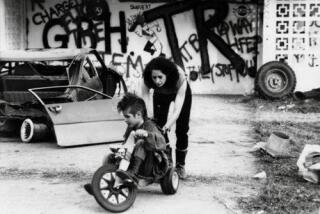When Big Is Better, Only a ‘Burban Will Do
- Share via
Martha Stewart is chauffeur-driven in hers. O.J. Simpson was ferried from the Santa Monica courthouse in his after losing in civil court. Last month, rapper Notorious B.I.G. was gunned down in the mid-Wilshire district in his forest-green one. (He was in the passenger seat. He didn’t know how to drive.)
It seems that at every intersection of the disparate strands of contemporary culture, here comes a Suburban driving through.
For soccer moms toting their kids, mortgage brokers towing their boats, rap stars hauling their crews, Suburbans are sought after for one basic reason: They are the biggest thing around.
At 219 1/2 inches long--nearly 3 1/2 feet longer than a Saturn coupe--the three-ton Suburban is the behemoth of the road, the Mack Daddy of the sport utility vehicles. Born as a humble truck with hard vinyl interior 30 years ago, it has enjoyed insatiable demand since its last restyling in 1992 and the boom in sport utility vehicles.
For rappers, the Suburban is what Cadillacs were to 1970s R & B stars. And it makes a statement of grandiosity that a little sports car can’t deliver. (Besides, you can’t quite imagine Notorious B.I.G., who was 6-foot-3 and 380 pounds, wedging himself into a Ferrari.)
“It’s the national vehicle of Texas,” says Ken Gross, director of the Petersen Automotive Museum. “When people joke about ‘Bring your ‘burban, they don’t mean Jack Beam.”
Practicality Meets Stylishness
Long ago, forest rangers and deliverymen drove Suburbans. Texans who needed to tow horse trailers discovered them about 15 years ago.
By the late 1980s, the Suburban had acquired basic interior creature comforts and fans among mainstream drivers. General Motors’ latest changes rounded and smoothed out the hard edges to give it a contemporary look.
Other domestic sport utility vehicles have higher sales, but the Suburban--manufactured in essentially identical GMC and Chevrolet models--is the station wagon of today for affluent parents of young children. The phenomenon of small, fashionably wraith-like women climbing into these hulking vehicles can be observed all over L.A. and beyond.
Unlike station wagons, there’s nothing geeky about the Suburban.
“I wanted the coolest four-wheel drive to pull my boat,” says investment property mortgage broker Don Simkins (who no longer has the boat but still has the truck).
Suburban owners will tell you that their car--truck, rather--is the perfect marriage of practicality and stylishness.
“They’re good for towing a lot of kids to weekend events--soccer, baseball,” says Simkins, a 34-year-old father of three who estimates there are five Suburbans in his Irvine subdivision of 20 homes.
The truck, which gets about 13 miles per gallon on city streets, retails from about $33,000 to $40,000 and is sold in both two-wheel- and four-wheel-drive version. Its height, width and length (it’s 15 inches longer than its closest competitor, the Ford Expedition) make it impossible to park in some garages. But that’s not the point.
“Auto culture is about two things and two things alone--freedom and mobility,” says Michael Marsden, a Northern Michigan University dean and a former professor of popular culture at Bowling Green State University in Ohio. “If you think about those two things, there’s no weather condition, there’s no road condition that will keep you from going where you want to go in a Suburban.”
Marsden likens the vehicle to a modern Conestoga wagon braving the frontier. “We believe this will tame our wilderness,” he says.
In fact, few Suburban owners are facing a wilderness harsher than a snowy drive to Mammoth. “For most of our clients, going off road is crossing the polo field,” says Peter Cameron, a car customizer in San Diego.
“They have a following for people who don’t use them in any of the ways they were intended--except for carrying people,” says the Petersen’s Gross.
That, explains Marsden, is its very appeal: taking a vehicle made for, say, hauling lumber and flaunting it as a status symbol in the valet parking lane at the trendiest restaurant in town.
“It’s what people would not expect,” says Marsden. “A lot of auto cultures are about inversion--turning things on end.”
Owners and observers rave about the sense of safety people feel in this cocoon. “Outside of getting hit by a Mack truck, you are the Mack truck,” says Thousand Oaks Chevrolet dealer Ed Kirkpatrick.
Indeed. While there are twice as many cars on the road as light trucks, more Americans die in crashes involving a car and a light truck than in collisions between two cars--and most of the people who die are in the cars.
As sport utility vehicles go, the Range Rover is more expensive and a tad tonier. But nothing beats the Suburban for size and possibilities for conspicuous customization that can run an extra $40,000.
“The Suburban has had allure for people with money who’ve been willing to spend more than the cost of the vehicle to customize it,” says customizer Cameron, whose shop outfits Suburbans with sound systems, TVs, tear gas jets, bulletproof windows (that was for a Mexican banker) and an occasional refrigerator. “In case you want a six-pack,” Cameron guesses.
The craving for such extras is particularly American, says culturalist Marsden. “If you think about the Suburban, it’s the extension of the suburban house.”
Or your fortress. Secret Service agents use heavily armored ones in presidential motorcades.
The very hugeness of the vehicle, speculate some observers, is a draw in itself.
Less than two decades ago, Americans suddenly spurned gas guzzling hulkmobiles in deference to the oil crisis. But now, says Todd Boyd, assistant professor of critical studies in USC’s film and TV school, they’re back--along with vintage vices like smoking cigars and drinking martinis. “I think the Suburban fits perfectly in that equation. . . . When you’re driving it, you’re saying, ‘I am commanding the road. No one is bigger than me.’ That is very American.”
Irvine mortgage broker Simkins drives to work in Downey in a black Mercedes 190E. But come the weekend, he and his wife think nothing of loading guests into the Suburban and going off to dinner.
“You can pull up to the Ritz Carlton Hotel and not feel unusual at all,” Simkins said.
Not everyone is being so sedate in their Suburbans. It is the vehicle of choice for drug dealers in Tijuana. San Diego matron Betty Broderick was driving one when she rammed into the front door of her ex-husband, whom she was later convicted of murdering.
There’s a downside to all this road bulk. In 1995, Consumer Reports put the Suburban on its list of least reliable automobiles of 1987-93 vintages. (It had plenty of company from other sport utility vehicles.)
They also don’t brake as fast as smaller cars, say some people who work on them. “They’re sadly lacking brakes,” San Diego customizer Cameron says. “We put on a racing-type brake.”
Of course, brakes are just a small part of the package Cameron provides for his customers. For one client, he took a $30,000 car and put $95,000 worth of customization on it--suede interior, supercharged engine, television, custom paint--then had it air-freighted to Switzerland for an additional $18,000.
Understatement, of Sorts
Which brings up an obvious point: People who could afford other things get the Suburban--in addition to their other things.
“Our average Suburban owner has an S class Mercedes, a Porsche, a 7 series BMW owner--either one or most of the above,” says Andy Cohen of Beverly Hills Motoring Accessories.
Cohen outfits the Suburbans of the stars--saxophonist Kenny G, actor Andy Garcia, Janet Jackson and her brother Randy, “Beverly Hills, 90210” stars Jennie Garth and Tiffani-Amber Thiessen.
He says he refused to sell one to O.J. Simpson shortly after his criminal trial concluded.
“A week after he got acquitted, he came in, and I said I wasn’t interested in selling him a Suburban,” says Cohen. “He said, ‘I’m not guilty.’ I said, ‘In my mind you are guilty.’ ”
Cohen lavishes Mercedes quality leather bucket seats, carpeting and wood finish on clients’ Suburbans.
Bruce Meyer, the owner of Geary’s in Beverly Hills, is one of Cohen’s Suburban clients despite having an extensive collection of classic and race cars--including Clark Gable’s Mercedes.
Like many Suburban owners, Meyer, 55, had his third one, a white two-wheel-drive model, “tricked out” with racy touches. “It’s kind of a bad boy,” he says affectionately.
Despite the extras, Cohen says many of his customers actually believe they have opted for understatement--after all, it’s not a limousine--and safety.
He insists no one gets bulletproof protection unless they are first checked out by a law enforcement agency that he declines to identify. “Those of questionable background we won’t sell to,” he says.
Once you pass his legitimacy screening, Cohen can bulletproof your Suburban so it withstands an AK-47, not to mention the force of the 9-millimeter that probably took out Notorious B.I.G.
“If he had been in one of our bulletproofed Suburbans,” says Cohen, “he’d be walking.”







